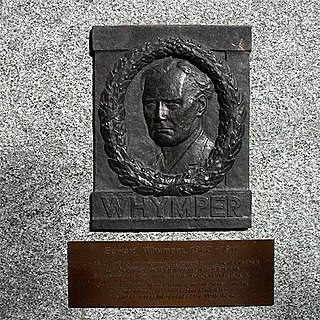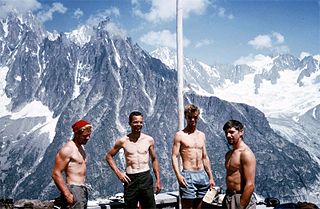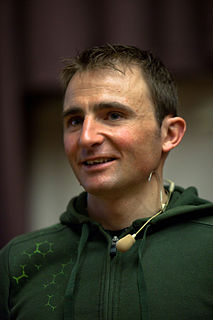
The 1936 Eiger north face disaster, which began on 18 July 1936, resulted in the death of five climbers during the 1936 climbing season on the north face of the Eiger.
After a deadly and unsuccessful German attempt [1] in 1935, ten climbers from Austria and Germany travelled to the still-unclimbed north face of the Eiger in 1936, but, before serious summit attempts could get underway, one climber was killed during a training climb. The weather was so bad that after waiting for a change and seeing none on the way, several climbers gave up. Only four remained: two Bavarians, Andreas Hinterstoisser and Toni Kurz, the youngest of the party, and two Austrians, Willy Angerer and Edi Rainer.
The weather improved and they made preliminary explorations of the lowest part of the face. Hinterstoisser fell 37 metres (121 ft) but was not injured. A few days later the four men began ascending the north face. They climbed quickly, but on the second day, the weather changed; clouds came down and allowed observers on the ground only intermittent visibility to the climbers on the face. On the second day the party was bombarded by rockfall, a notorious problem on the north face route. Angerer was hit just below the shoulder blade and injured, though it is said that he tried to continue climbing. He certainly did not call for a retreat at the time.
They did not resume climbing until the following day, when, during a break in the clouds, the party was observed descending. Later, it would be learned that the group had no choice but to retreat, since Angerer had suffered more serious injuries from the falling rock than at first thought. The party became stuck on the face when they could not recross the very technical and difficult Hinterstoisser Traverse, from which they had pulled the rope during their ascent. Exhausted on their third day of climbing, with two days of bad weather, it is said that Hinterstoisser still tried for hours to cross the traverse, but it was impossible in the poor conditions. Hinterstoisser had used a technique called a "tension traverse", where a rope is fixed and kept taut, allowing the lead climber to "lean" on it for balance. This technique was not possible descending though. The bad weather would have also meant wet and / or icy rock compared to dry conditions on the ascent.
The group decided to abseil down the vertical face (the great rock barrier) to the base of the mountain. [2] Contact was made with a railway guard at the Eigerwand railway station halfway down the descent. During their exchange the climbers amazingly said that everything was all right (perhaps out of pride and knowledge that they were very close to safety). However, as Hinterstoisser set up the last abseil of the descent, an avalanche came down the mountain, taking Hinterstoisser, who had unclipped from the group, with it. He was found at the bottom of the mountain days later. Willy Angerer fell and was killed by the impact of his body against the rock face, and Edi Rainer quickly asphyxiated from the weight of the rope around his diaphragm. Only Kurz survived the avalanche, hanging on the rope with his dead comrades. [3]
Late on the third day three Swiss guides started a rescue attempt from the Eigerwand Station. They failed to reach Kurz but came within shouting distance and learned what had happened. Kurz explained the fate of his companions: one had fallen down the face, another was frozen above him, and the third had fractured his skull in falling and was hanging on the rope below him. [4]
In the morning the three guides returned, traversing the face again from a hole near the Eigerwand Station despite avalanche-prone conditions. Toni Kurz was still alive but almost helpless. After four nights exposed to the elements, one of his hands and his arm was completely frozen. Kurz hauled himself back to the mountain face after cutting loose Angerer below him. The guides were not able to pass an unclimbable overhang that separated them from Kurz, but they managed to get a rope long enough to reach Kurz by tying two ropes together. While abseiling, however, Kurz could not get the knot that joined the two ropes to pass through his carabiner. He tried for hours to reach his rescuers, who were just a few metres below him, desperately trying to move himself past the knot, but in vain. He then began to lose consciousness. One of the guides, climbing on another's shoulders, was able to touch the tip of Kurz's crampons with the head of his ice-axe but could not reach higher. [4] Faced with the futility of his situation, he famously said only "Ich kann nicht mehr" ("I can't [go on] anymore") and then died. [5] [6]
His body was later recovered by a German team.

















